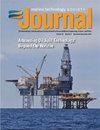Remapping of Temperature Profile Measurements in OMNI Buoy Systems
IF 0.7
4区 工程技术
Q4 ENGINEERING, OCEAN
引用次数: 0
Abstract
Abstract The OMNI (Ocean Moored Buoy Network for northern Indian Ocean) buoy network comprises 12 buoy systems that measure surface meteorological parameters along with temperature and salinity profile measurements at discrete levels up to 500 m. All the OMNI buoy systems are deployed with slack-line moorings, which respond more to wind, wave, and current forcing compared to taut-line mooring. Subsurface temperature measurements are subject to change depending on both environmental condition and mooring design. The standard sensor fit of the OMNI buoy systems has only one pressure sensor fixed at 500 m, which shows significant depth variability. In order to see the spatial and seasonal variability in the vertical movement of the mooring line and the associated temperature variability, four deployments with additional pressure measurements at 200 m are analyzed. It is observed that the depth/temperature variability exhibits significant seasonality with maximum variability during pre-monsoon season. Also, the effect of this movement in the shallower depths is analyzed with four more pressure sensors in the mooring line for a 1-year period in the central Bay of Bengal. The analysis shows that the maximum value of average and root mean square (RMS) temperature deviations is 0.38 °C and 0.48 °C in the deepest interpolated depth at 400 m where the mooring line experiences a greater range of motion and the actual temperature variability in shallower depths is negligible particularly up to 75 m (<0.01°C). The study reveals the necessity of additional pressure measurements for better remapping of temperature profile measurements.OMNI浮标系统温度剖面测量的重映射
OMNI(北印度洋海洋系泊浮标网络)浮标网络由12个浮标系统组成,这些浮标系统可以测量海面气象参数以及高达500米的离散水平的温度和盐度剖面。所有OMNI浮标系统都采用了松绳系泊,与紧绳系泊相比,它对风、浪和水流的作用力反应更大。根据环境条件和系泊设计,地下温度测量值可能会发生变化。OMNI浮标系统的标准传感器配合只有一个固定在500米的压力传感器,这显示出明显的深度变化。为了了解系泊线垂直运动的空间和季节变化以及相关的温度变化,分析了在200米处进行的四次额外压力测量。观测结果表明,深度/温度变化具有明显的季节特征,季风前季节变化最大。此外,在孟加拉湾中部为期1年的系泊线上,使用另外四个压力传感器分析了这种运动在较浅深度的影响。分析表明,在400 m的最深插值深度中,平均和均方根(RMS)温度偏差的最大值为0.38°C和0.48°C,其中系泊线经历了更大的运动范围,而较浅深度的实际温度变化可以忽略不计,特别是在75 m以下(<0.01°C)。研究表明,为了更好地重新绘制温度剖面测量值,有必要进行额外的压力测量。
本文章由计算机程序翻译,如有差异,请以英文原文为准。
求助全文
约1分钟内获得全文
求助全文
来源期刊

Marine Technology Society Journal
工程技术-工程:大洋
CiteScore
1.70
自引率
0.00%
发文量
83
审稿时长
3 months
期刊介绍:
The Marine Technology Society Journal is the flagship publication of the Marine Technology Society. It publishes the highest caliber, peer-reviewed papers, six times a year, on subjects of interest to the society: marine technology, ocean science, marine policy, and education.
 求助内容:
求助内容: 应助结果提醒方式:
应助结果提醒方式:


